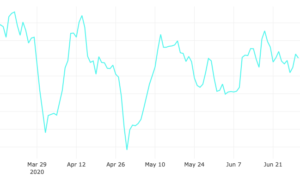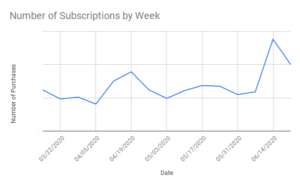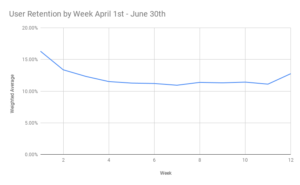When I first started this series, in the wake of what I like to call “The Great Upheaval,” its initial mission was to examine, on a weekly basis, the dynamic nature of the crisis from a publisher’s perspective, and to share Keywee’s birds-eye-view.
Three and a half months later, and what we initially thought may be temporary is slowly becoming a permanent transformation.
A couple of weeks ago, I talked about that transformation in the context of eCommerce and affiliate efforts. This week I want to talk about what that transformation looks like for paid subscription campaigns. Let’s dive in.
Steady As She Goes
I tend to use March 15th as the point of inflection, when the world started turning sideways and the rule book was thrown out the window.
There was a lot of volatility in the ensuing few weeks, but somewhere around May, things started to steady and become consistent.
Let’s look at the spend on subscription campaigns – which is a clear illustration of this shift:
As you can see, May-June, compared to March-April, are far less volatile. There are no huge peaks and valleys that are outside the norm.
Now let’s look at volume. Publishers reported a spike of subscribers coming in as the crisis was unfolding. There was some worry that this number would go down, but when you look at the data, the volume hasn’t decreased at all. In fact, it’s on a slight upward trajectory:
Another interesting point of note: CPCs are still low, but are increasing gradually over time. The fact that spend continues to be high despite the increase means that CPAs are still trending low across the board.
So volume is still high, and costs are still low. But what about quality? At the beginning of The Great Upheaval, publishers were worried about user retention, fearing that readers wouldn’t stick around once they subscribed. That never materialized either. The chart below shows user average user retention over 12 weeks after the initial subscription date:
I find this data point to be particularly telling. No huge drop-off at all. Users, on the whole, are sticking around.
Seeing all this data together indicates that this is a full-blown transformation rather than a passing trend. There have been millions of words written over the last few months about content consumption being on the rise, and people willing to open their wallets for content that they find worthwhile, so I won’t take up more space on the topic. The TL;DR is that this is happening, and it seems like it’s here to stay.
Planning for the Long Haul
Given this landscape, it’s time for publishers to start making the most of it, and plan an effective strategy for the long haul. This means opening up their data and looking at how to structure their campaigns to maximize ROI.
Today, I want to look specifically at strategies for retention campaigns. Setting aside a budget every month to ensure your subscribers return is an important factor ensuring a high lifetime value per user.
As I mentioned above, retention numbers are steady, but to keep them steady, publishers need to invest in a long-term strategy.
When it comes to retention campaigns, there are three primary targeting strategies that can be used:
1. Starters
This strategy targets recent subscribers to ensure that they return to the site regularly and create a reading habit that encourages loyalty and increases the likelihood of renewal. It’s important to take reader habits into account for this strategy. Let’s say a subscriber initially came in as a result of COVID-19 coverage but has since spent more time reading sports articles. They should be presented with sports content because that’s the core of their interactions.
2. Sleepers
This strategy targets users that haven’t been active since they initially subscribed. They have a high likelihood of churning, so setting aside budget to encourage engagement from this user segment proves to be effective. For this scenario, it’s worthwhile to promote content that really speaks to a publisher’s unique tone of voice and value proposition.
3. Low Propensity Readers
This strategy targets users with declining engagement numbers that haven’t gone dormant but are in danger of doing so. For this, a combination of unique content and frequently visited content provides a good mix.
The Bottom Line
We’re living through a volatile period, and through it all, it’s clear that users are turning to publishers to provide steady, reliable information and entertainment. It’s also clear that these users are ready and willing to open up their wallets for these things.
The key to making the most of this transformation is having a solid strategy that is ready for the long haul. Measurement shouldn’t end at the first conversion event. Users are ready and willing to stick around, and it’s critical that publishers encourage them to do so by creating as many engagement opportunities as possible.
And as always, if you’d like to take Keywee for a spin and find out how we can help you with your distribution and user retention strategy, click here to book a demo.




